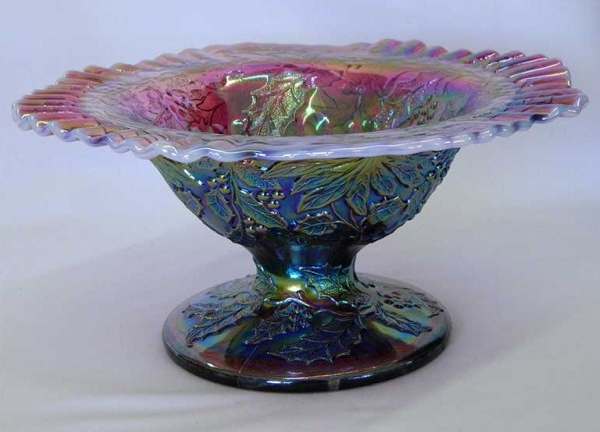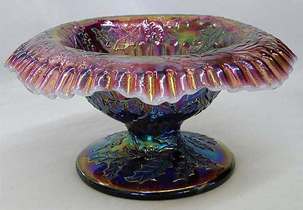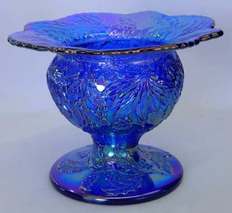A comport is not just for Christmas - the Story Behind the Glass
The iconic and very beautiful Christmas Compote - originally made by Dugan and reproduced by Fenton for Antique Publications
Written with grateful thanks to Seeck Auctions for their images and to Glass Collectors Digest.
Written with grateful thanks to Seeck Auctions for their images and to Glass Collectors Digest.
We now know that Dugan was making Carnival Glass from as early as 1908, but the early pioneers who collected, researched and documented Carnival Glass - pioneers like Marion Hartung and Rose Presznick - did not recognise this, and it was not until 1981 that the significant Carnival Glass production by Dugan, and later by Diamond was truly known. Up to that point, many of the pieces that we now know to be Dugan-Diamond, were attributed to other makers, including to Northwood and Millersburg due to the excellence of the glass.
A case in point was the Christmas Compote (or Christmas comport), which was considered to be a Northwood or a Millersburg piece due to its quality and rarity. Below, on the left is an extract from The Western Collector of October 1970 showing the early, incorrect attribution to Millersburg (and that it had been made as an employees' Christmas present).
We now know otherwise: the magnificent Christmas Compote was made by Dugan in around 1909. The attributions to Dugan-Diamond result from brilliant detective work by Del Helman and the late William Heacock. Del and his father dug up and analysed glass shards at the Indiana (Pennsylvania) glass factory site - the "Dugan dump"). The results, published in 1981, gave the key clues to Dugan-Diamond's Carnival Glass production. Much later, in 1997, the original mould for Dugan's Christmas Compote was discovered (of which, more later). The mould was stamped on the side with Dugan's trademark - a D in a diamond - a mark that was used from 1906. Proof if it were needed.
Discovering Dugan's original mould
The original Dugan mould, with their D in a diamond trademark stamped on the metalwork (not on the glass itself), was found early in 1997 by Dave Richardson, James Measell and Bud Ward. Dave, the Publisher of the Glass Collectors Digest, took the mould to the Fenton Art Glass Company where it was cleaned up and put into working order in Fenton's mould shop.
To ensure that any contemporary production of the Christmas Comport would not be mistaken for the rare (and expensive) Dugan original, the mould was marked "GP" for Glass Press (and later with "AP" for Antique Publications), and the cursive F in an oval that Fenton used on moulds that were not their own. Dave also undertook that the contemporary item would not be made in the two colours - marigold and purple - in which Dugan made the original item.
Dave Richardson arranged for some initial trial runs to be carried out by Fenton - mulberry blue, teal and topaz opalescent. The samples were taken to the 1997 convention of the International Carnival Glass Association in Dayton Ohio, where we had the privilege of meeting Dave and seeing these wonderful pieces. It also cemented our ongoing relationship with Antique Publications; we had written a number of major articles about Carnival Glass that they had published in previous years.
Subsequently, Dave and Fenton went on to make several more limited edition runs in various Carnival colours, as shown in the ads below. Dave Richardson was particularly keen to make the Christmas Compote in red and green Carnival and as the ads show, he realised that ambition.
Here are two advertisements from Glass Collectors Digest from December/January 1998 (left) and June/July 1998 for the sale of limited edition runs that Fenton made for Antique Publications.
The contemporary reproductions (made by Fenton for Antique Publications).
The contemporary Christmas Compotes were made in the regular compote/comport shape as shown in the ads above. But the master glassmakers at Fenton did not stop there! As with many Carnival club commemoratives, they used their considerable skill to fashion variously shaped whimsey items like the ones pictured below. The range of shapes produced from the one mould clearly demonstrate its versatility in the hands of skilled glassmakers.
The contemporary Christmas Compotes were made in the regular compote/comport shape as shown in the ads above. But the master glassmakers at Fenton did not stop there! As with many Carnival club commemoratives, they used their considerable skill to fashion variously shaped whimsey items like the ones pictured below. The range of shapes produced from the one mould clearly demonstrate its versatility in the hands of skilled glassmakers.
Pictures are courtesy of Seeck Auctions.
The mould was subsequently sold by Antique Publications. It is in private hands and has since been worked by Mosser.
Fenton also revived another well-loved classic Dugan-Diamond pattern - read all about the Butterfly and Tulip revival.
Read more of The Stories Behind The Glass in Carnival Glass Times












